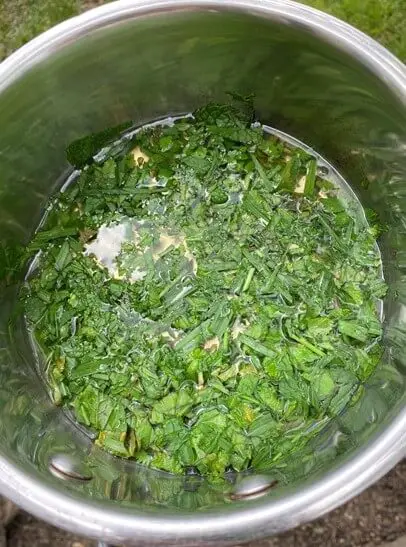Estimated reading time: 9 minutes
Nice weather pulls us all outside to enjoy hikes, bonfires, gardening, and other outdoor activities. The last thing any of us want while enjoying the great outdoors is annoying stings from mosquitos.
I tend to get an allergic reaction to the frustrating biters, leaving me with large swollen welts that are hard to ignore. Whether your reaction is like mine or just a nuisance, you want to be prepared.
Though there are plenty of bug repellants available for purchase, DEET is a powerful chemical to put on your skin. Though it is deemed safe by the Environmental Protection Agency, there are studies that continually examine the risk of the chemical to humans, particularly children. For this and other reasons, you may want to consider creating your own herbal bug repellent.
Essential oils derived from plants are a great option for an herbal bug repellent. However, you will want to ensure that you are using high-quality oils. Since obtaining those products can take a hit on your pocketbook, consider a garden full of mosquito-repelling herbs and plants that will allow you to make a DIY bug spray.
Want to save this post for later? Click Here to Pin It On Pinterest!
What Are Bug Repelling Herbs?
There are several herbs and plants that you can consider adding to your homemade bug spray. For this recipe, I am using fresh herbs, though you can sub in dried herbs as well. Which leads us to ask, what plants work and why?
1. Citronella Grass
Citronella is the most widely known plant for mosquito prevention, giving off a scent that mosquitos hate. It is great to add to a DIY bug spray, but also to plant in your yard to give some additional mosquito prevention.
As a grass, a citronella plant will clump together and can get up to 5 or 6 ft tall. This plant does not like a frost, so be mindful of when you plant, and give it plenty of space. It can work well in a large pot.

Many stores and plant nurseries sell ‘mosquito plants’ that are actually citronella-scented geraniums and will not be as effective without the true citronella oil. This plant has a lacier leaf and is not a grass.
When you crush the leaves, you immediately are hit with the scent of citronella, which mosquitos do not like. You can add it to your natural mosquito repellent; just be sure to know the difference between the true variety of citronella plants.

If you cannot find citronella grass, lemongrass is a relative of the plant and has citronella oil inside of it, making it a solid choice for substitution. Lemongrass can grow 3-5 ft tall.
2. Mint Plants
Mint plants seem to repel mosquitos with their strong scent. In the same way, this is a pleasant plant to add to the DIY bug spray because it smells great and naturally gives a cooling feel.
However, when planting it in the garden, keep in mind that mint plants tend to be invasive, so a free-roaming herb garden or a pot may be the best choice for planting.
3. Catnip/Catmint

More surprising of a mosquito repellant is catnip! The same smell the cats love is exactly what the mosquitoes hate. According to ScienceDaily.com, catnip is more effective than DEET in repelling mosquitos:
“Researchers report that nepetalactone, the essential oil in catnip that gives the plant its characteristic odor, is about ten times more effective at repelling mosquitoes than DEET — the compound used in most commercial insect repellents.”
This plant gives great protection against these pests when planted in the garden and applied in a bug spray. Catnip can be invasive in the garden, like other plants in the mint family.
4. Rosemary

Rosemary is a great herb to have in your garden to throw in with some summer grilled veggies, and the strong fragrance of rosemary can help keep mosquitoes and flies away, making it great to add to natural bug spray and to your herb garden. Using it as an add-on to your grilled meal will help boost some mosquito deterrent for your patio.
5. Basil

A great contribution to a salad, pesto, or pasta sauce, any home garden should have at least one pot of basil. Basil’s aroma is strong enough that you don't even have to crush the leaves to get the benefit of repelling mosquitoes.
Basil is also toxic to mosquito larvae, so place it near areas of your yard that may have some standing water to discourage mosquitos from laying eggs in the area. Mosquitos reproduce in stagnant water.
6. Lavender

Lavender is a calming and positive smell to humans, but it is overwhelming to mosquitos and acts as a great addition to a deterrent. It is a beautiful purple flower, which brings a visual appeal in the garden, but it also adds some protection against other bugs and grazing animals.
Additional herbal options for your bug spray: lemon balm, sage, cloves.
There are many other herbs and flowers you can plant in the garden to discourage flying pests that impede backyard pastimes; however, these listed herbs are some of the best options for you to consider wearing topically.
Mosquito deterrents for the yard and garden include garlic, mums, bee balm, marigolds, floss flower, scented geranium, alliums, and more.
Now that we have covered things we can grow, let’s harvest some of nature’s medicine and turn it into a family-friendly bug spray.
Supplies Needed:
- Reusable spray bottle
- Bug repelling herbs (8-10 tablespoons)
- Distilled water (1 cup)
- Witch hazel (1 cup)
- Strainer or cheesecloth
- Pot with lid

Steps:
1. Boil the distilled water. Pouring the liquids and collecting herbs are great steps to get the kids involved.

2. While you wait for it to boil, chop, or crush the herbs to release their natural oils and aromas.

3. Once your water hits a rapid boil, turn off the heat. Immediately add your prepared herbs and cover the pot with a lid. You want to trap in all smells and moisture to the pot. Allow the water to cool completely while steeping the herbs.

4. Strain the herbs from the water.

5. Be sure to squeeze out all liquids possible.

6. Combine the witch hazel with the infused water.

7. Pour the mixture into a spray bottle, and you are ready to repel!

With any natural remedy, always try the finished product on a small patch of skin before full application to make sure that there are no allergic or adverse reactions.
Like this post? Don't Forget to Pin It On Pinterest!











